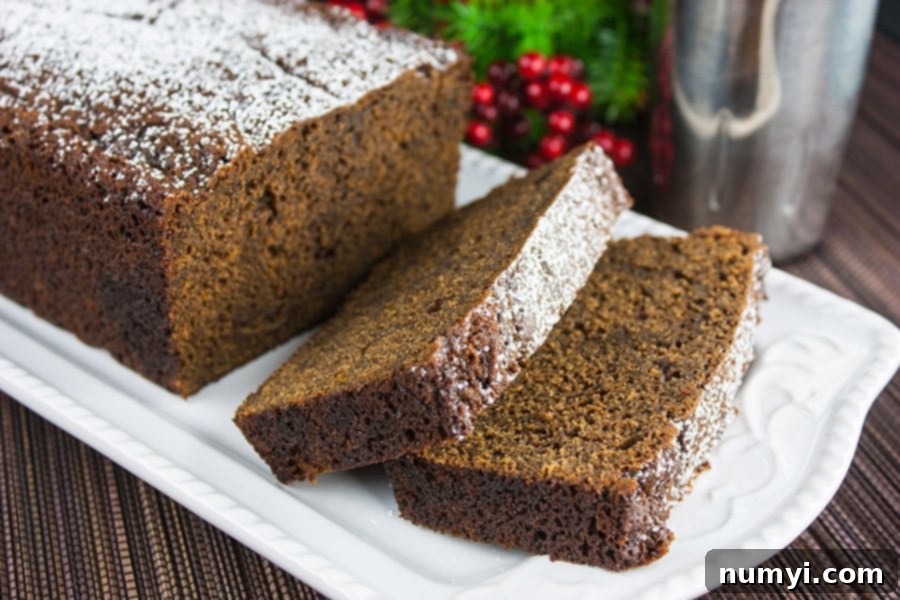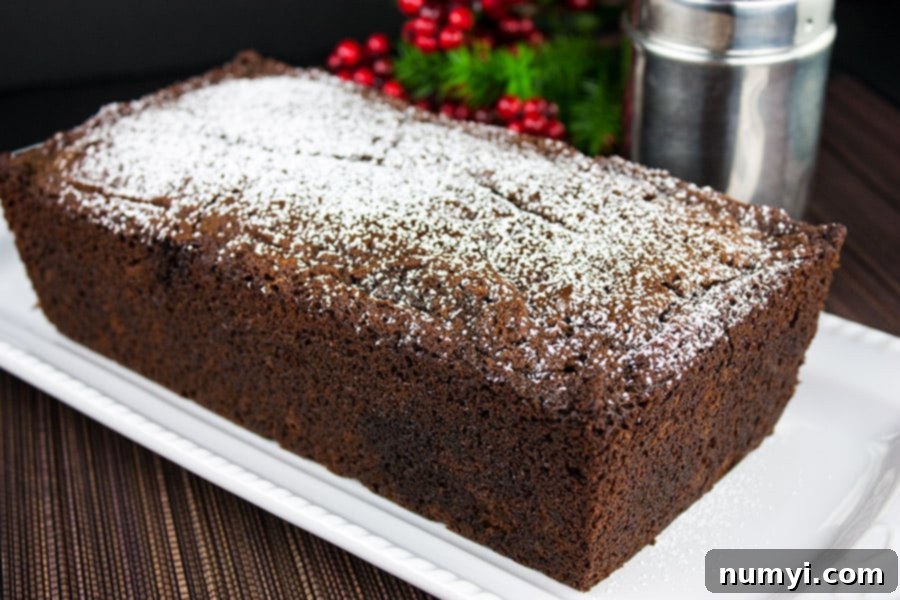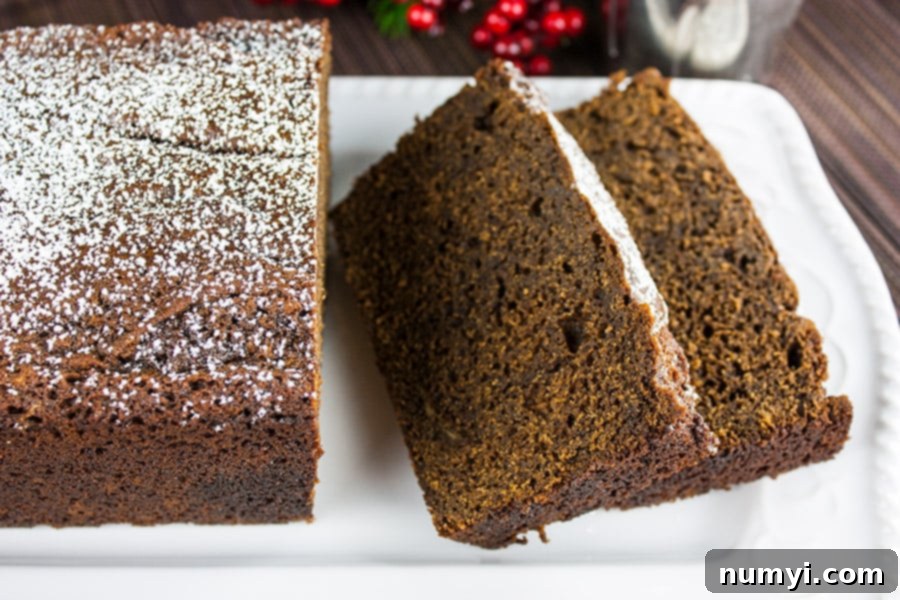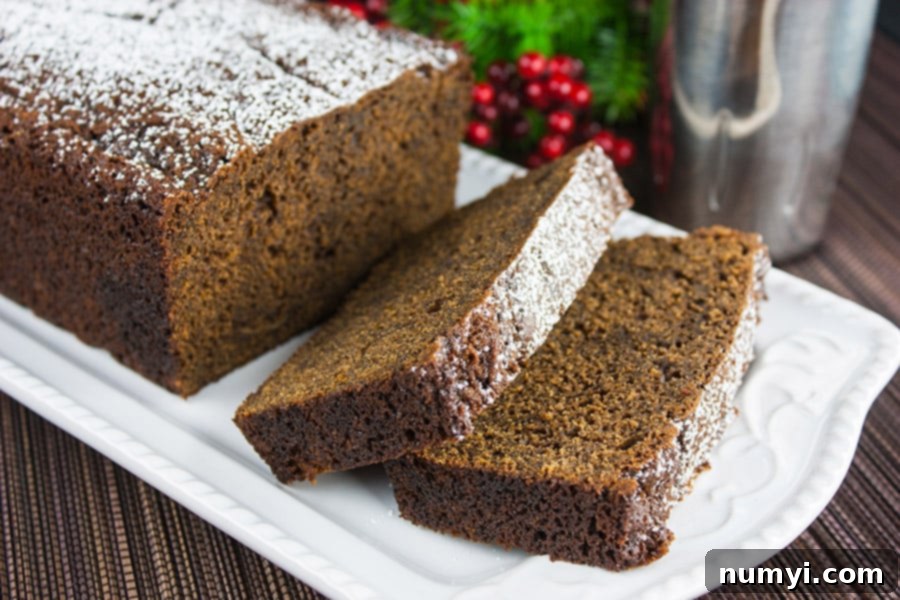The Ultimate Moist & Spicy Gingerbread Loaf Recipe: A Holiday Favorite
There’s something uniquely comforting about the aroma of freshly baked gingerbread filling your home. This **Spicy Gingerbread Loaf** isn’t just any ordinary quick bread; it’s a culinary masterpiece that promises a delightful blend of warmth, spice, and irresistible moisture. Imagine a slice that’s perfectly soft, subtly sticky, and bursting with the festive flavors of cinnamon, ginger, cloves, and molasses. It’s the kind of treat that transforms an ordinary moment into a special occasion, whether it’s a brisk autumn afternoon or a cozy winter evening.
Our recipe for gingerbread loaf delivers an unparalleled taste experience. It’s designed to be effortlessly moist, thanks to a careful balance of key ingredients, and deeply flavorful, with a generous hand of aromatic spices. Forget dry, crumbly gingerbread – this loaf is pure indulgence, melting in your mouth with every bite. It’s an ideal companion to your morning coffee, a welcome afternoon snack, or a spectacular yet simple dessert that will impress family and friends alike. Prepare to fall in love with the rich, robust notes and the perfectly tender texture of this homemade gingerbread.

Why This Spicy Gingerbread Loaf Will Be Your New Favorite
This gingerbread loaf offers a host of reasons to become a staple in your baking repertoire. It’s more than just a sweet treat; it’s an experience. Here’s why you’ll absolutely adore this recipe:
- Unrivaled Moisture and Texture: Unlike many gingerbread recipes that can turn out dry, this loaf is incredibly moist, soft, and slightly sticky – the hallmark of truly perfect gingerbread. Its tender crumb is a result of carefully selected ingredients like buttermilk and butter, ensuring a delightful mouthfeel with every slice.
- Perfectly Spiced Flavor: We don’t hold back on the spices here! A generous blend of ground ginger, cinnamon, cloves, allspice, and nutmeg creates a harmonious, robust flavor profile that is both warming and invigorating. Each spice plays a crucial role in delivering that classic, beloved gingerbread taste.
- Effortlessly Simple: This is a quick bread recipe, meaning no yeast or complicated proofing steps are involved. It comes together quickly with minimal fuss, making it ideal for both seasoned bakers and beginners. You can whip up a batch in no time, filling your kitchen with an intoxicating aroma.
- Versatile for Any Occasion: While it shines brightly as a festive dessert during the Christmas holidays, this gingerbread loaf is wonderfully versatile. Enjoy it for breakfast with your morning coffee, as a satisfying afternoon snack, or as a cozy evening treat. It truly needs nothing more than a simple dusting of powdered sugar to be utterly exquisite.
- Better Than Store-Bought: Forget the often overly sweet or lackluster store-bought versions. This homemade gingerbread loaf boasts a depth of flavor and a superior texture that is simply ten times better than anything you’d find at a coffee shop like Starbucks.
- Aromatherapy for Your Home: The process of baking this loaf fills your entire home with the most incredible, comforting scents of ginger, cinnamon, and molasses. It’s an instant mood booster and a wonderful way to welcome guests or simply create a cozy atmosphere.
There’s no need for elaborate frostings or excessive butter with this gingerbread. A simple dusting of powdered sugar is all the adornment it requires, allowing the rich, spicy flavors to truly shine. If you appreciate a full-flavored, soft, and wonderfully moist gingerbread, this recipe is guaranteed to become a cherished favorite.
Are you looking for more holiday treats to bake this year? Beyond this amazing gingerbread loaf, be sure to explore our delightful chocolate covered pretzel rods, cozy eggnog cookies, and the classic taste of our copycat Walker’s shortbread recipe for a truly festive baking season.

What is Gingerbread? Exploring its Rich History and Forms
Gingerbread is a broad and delightful term that encompasses a wide variety of baked goods, all united by their characteristic use of warming spices like ginger, cinnamon, cloves, and often molasses. Its history stretches back centuries, with roots tracing to ancient civilizations and trade routes that brought exotic spices to Europe. Originating in various forms, from spiced honey cakes to crispy biscuits, gingerbread has evolved into a beloved treat enjoyed across cultures.
The texture of gingerbread can vary dramatically. It can be soft and cakey, like our delicious loaf, offering a tender crumb that melts in your mouth. Or it can be crispy and crunchy, often found in thin gingerbread cookies perfect for dunking in tea. Iconic gingerbread houses, known for their intricate designs and edible decorations, are another popular manifestation, especially during the holiday season. The unifying factor across all these variations is the distinctive flavor profile, driven by the blend of pungent ginger and sweet, rich molasses, creating a truly unique and comforting taste.
Gingerbread vs. Ginger Cake: Understanding the Nuances
While the terms “gingerbread” and “ginger cake” are sometimes used interchangeably, there are subtle yet important distinctions, especially in traditional baking. Gingerbread, as we’ve discussed, is a more encompassing term that can refer to either cookies or cake-like preparations. Its defining characteristic is almost always the inclusion of molasses, which provides a deep, complex sweetness, a darker color, and a moist, dense texture. The molasses pairs beautifully with the traditional blend of ginger, cinnamon, and cloves, giving gingerbread its signature robust flavor.
Ginger cake, on the other hand, typically relies more heavily on granulated sugar for sweetness and often uses ground ginger as its primary spice, sometimes with fewer additional spices. While it still offers that wonderful ginger flavor, it generally lacks the deep, dark, and slightly treacly notes that molasses imparts. Ginger cakes tend to be lighter in color and may have a different crumb structure compared to the denser, stickier texture associated with traditional gingerbread. Our Spicy Gingerbread Loaf firmly falls into the gingerbread category, celebrating the rich and authentic flavors that molasses brings to the forefront.
Key Ingredients for the Perfect Spicy Gingerbread Loaf
Crafting a truly exceptional gingerbread loaf starts with understanding the role each ingredient plays. Here’s a breakdown of the essential components that give our loaf its incredible flavor and texture:
- Molasses: This is the heart and soul of traditional gingerbread. For our recipe, we highly recommend using a **robust, strong-flavored dark molasses** or even blackstrap molasses. It’s responsible for the gingerbread’s characteristic deep, slightly smoky sweetness, its rich dark color, and that wonderfully moist and slightly sticky texture. While you *can* use light or fancy molasses, opting for a darker variety will yield a more authentic and intense gingerbread flavor.
- Spices (Ground Ginger, Cinnamon, Cloves, Allspice, and Nutmeg): This quintessential blend creates the signature warming and aromatic profile of gingerbread.
- Ground Ginger: The star of the show, providing its distinctive pungent and warm kick.
- Cinnamon: Adds a sweet and woody warmth that complements the ginger.
- Cloves: Contributes a strong, sweet, and spicy aroma with a slightly bitter undertone, crucial for depth.
- Allspice: As its name suggests, it tastes like a combination of several spices (cloves, nutmeg, and cinnamon), tying the flavor profile together.
- Nutmeg: Offers a sweet, delicate, and slightly nutty flavor, enhancing the overall warmth.
Freshly ground spices will always yield the most vibrant flavors, so consider grinding your own nutmeg for an extra aromatic boost.
- Buttermilk and Unsalted Butter: These dairy ingredients are fundamental for achieving the loaf’s exceptional moisture and tender crumb.
- Buttermilk: Its acidity reacts with the baking soda, aiding in leavening and creating a tender texture. It also imparts a subtle tang that beautifully balances the sweetness of the molasses and brown sugar, adding complexity to the flavor. Ensure it’s at room temperature for optimal mixing.
- Unsalted Butter: Provides rich flavor and contributes significantly to the loaf’s moist and tender crumb. Using unsalted butter allows you to control the total salt content in the recipe. Like buttermilk, it should be at room temperature for proper creaming with sugar.
- All-Purpose Flour: The structural foundation of the loaf. Ensure you measure it correctly (aerating, spooning into the measuring cup, and leveling off) to avoid a dry or dense cake.
- Brown Sugar: Dark brown sugar, in particular, adds another layer of moisture and a caramelly note that harmonizes perfectly with the molasses. Its slight acidity also helps activate the baking soda.
- Eggs: Act as a binder, provide structure, and contribute to the richness and moistness of the loaf. Room temperature eggs emulsify better with the butter and sugar, resulting in a smoother batter.
- Baking Soda: The leavening agent that, when combined with the acidic buttermilk and brown sugar, creates carbon dioxide bubbles, helping the loaf rise and achieve a light, airy texture.
- Vanilla Extract: A touch of vanilla enhances all the other flavors, adding a subtle warmth and sweetness that rounds out the spice profile.
How to Make the Perfect Spicy Gingerbread Loaf
This quick bread recipe is wonderfully straightforward, promising a delicious result with minimal fuss. The key to success lies in proper ingredient preparation and careful mixing. As long as your eggs, buttermilk, and butter are at room temperature, you’re well on your way to gingerbread perfection!
Preparation is Key
- Preheat Oven and Prepare Pan: Begin by preheating your oven to 350°F (175°C) and positioning a rack in the middle. This ensures even baking. Prepare a 9×5-inch loaf pan by greasing it thoroughly with butter and then dusting it lightly with flour. Alternatively, a baking or cooking spray with flour can be used. This step is crucial to prevent the loaf from sticking.
- Combine Dry Ingredients: In a medium bowl, whisk together the all-purpose flour, ground ginger, baking soda, ground cinnamon, salt, ground allspice, ground cloves, and freshly ground nutmeg. Whisking not only combines the ingredients evenly but also aerates the flour, contributing to a lighter texture. Set this mixture aside.
- Prepare Buttermilk Mixture: In a separate measuring cup or small bowl, stir together the room temperature buttermilk and vanilla extract until well combined. This ensures the vanilla is evenly distributed throughout the wet ingredients.
Mixing the Batter to Perfection
- Cream Butter and Brown Sugar: In the bowl of a stand mixer fitted with a paddle attachment (or using a hand mixer), combine the room temperature unsalted butter and packed dark brown sugar. Beat on medium speed for about 5 minutes, or until the mixture becomes light in color, fluffy, and forms small, soft peaks. This creaming process incorporates air, which is vital for a tender loaf.
- Incorporate Molasses and Eggs: Pour the robust blackstrap molasses into the creamed butter and sugar mixture and beat until thoroughly combined. The mixture might look a little clumpy or even slightly curdled at this point, which is normal. Then, add the large eggs one at a time, beating well after each addition until each egg is fully incorporated into the batter. Scrape down the sides and bottom of the bowl with a spatula after adding the eggs to ensure everything is mixed evenly.
- Alternate Wet and Dry Ingredients (Crucial Step): This is where careful mixing is essential to avoid overmixing.
- Add approximately one-third of the dry ingredient mixture to the wet ingredients in the stand mixer. Beat on low speed *just until* the flour streaks disappear and the flour is incorporated.
- Next, add about half of the buttermilk mixture and mix until it’s smooth.
- Add another third of the flour mixture, mixing on low until just combined.
- Pour in the remaining buttermilk mixture and mix until incorporated.
- Finally, turn off the mixer. Add the last third of the flour mixture and, using a spatula or by hand, gently stir *just until* it’s incorporated and the batter is smooth. **DO NOT OVERMIX!** Overmixing develops the gluten in the flour too much, leading to a tough and dense loaf. A few small lumps are perfectly fine.
Baking and Cooling
- Bake the Loaf: Pour the prepared batter evenly into your buttered and floured 9×5-inch loaf pan.
- Bake Until Done: Bake for approximately 45 minutes. Baking times can vary depending on your oven, so start checking around the 35-40 minute mark. The loaf is done when a wooden toothpick inserted into the center comes out clean, and the edges of the cake begin to pull away slightly from the sides of the pan.
- Cool Properly: Allow the gingerbread loaf to cool in the pan for 10 minutes. This helps it set and prevents it from crumbling when removed. After 10 minutes, carefully invert the loaf onto a wire cooling rack and let it cool completely. Cooling completely on a rack allows air to circulate around the loaf, preventing sogginess and ensuring the perfect texture.

As the temperatures finally begin to cool, the allure of baking holiday treats becomes irresistible – and no judgment here! The deep, robust flavor of unsulphured blackstrap molasses truly shines in this loaf, creating an experience that’s hard to resist. I confess, this spicy gingerbread loaf is so good, it’s easy to enjoy most of it all by yourself!
So, go ahead and pour yourself (and a lucky guest, if you’re feeling generous) a steaming cup of your favorite hot beverage. Settle in and savor a slice of this perfect, sticky, homemade gingerbread loaf – pure heaven in every bite!

Expert Baking Tips for the Best Gingerbread Loaf
Achieving a consistently perfect gingerbread loaf is simple with these expert tips:
- Measure Flour Accurately: This is arguably the most critical step for any baking. To measure flour correctly, first aerate it by fluffing it with a spoon. Then, gently spoon the flour into your measuring cup until it’s overflowing. Finally, use the flat edge of a knife or a straight edge to level off the top. Scooping directly from the bag can pack too much flour, leading to a dry and dense loaf.
- Use Room Temperature Ingredients: Ensure your eggs, buttermilk, and butter are all at room temperature before you start mixing. Room temperature ingredients emulsify more easily, creating a smooth, well-combined batter. This smooth batter holds air better, which helps the loaf rise evenly in the middle, preventing that common problem of a sunken center.
- DO NOT Overmix the Batter: Once you start adding the flour, mix on the lowest speed only until the ingredients are just combined. Overmixing develops gluten, which can make your gingerbread tough and chewy instead of tender and moist. A few streaks of flour are better than an overmixed batter.
- Know Your Oven: Every oven is a little different, and baking times can vary significantly. Don’t rely solely on the recipe’s stated baking time. Start checking your gingerbread loaf around 30-35 minutes into the baking process. Use the toothpick test to determine doneness (it should come out clean). If the top is browning too quickly, you can loosely tent it with aluminum foil.
- Proper Cooling is Essential: Don’t rush the cooling process! Allowing the loaf to cool in the pan for 10 minutes helps it firm up before you transfer it. Then, cooling it completely on a wire rack ensures air circulation, preventing condensation and a soggy bottom.
Delicious Variations and Serving Suggestions
While this spicy gingerbread loaf is fantastic on its own, there are many ways to customize and serve it to suit your preferences:
- Cream Cheese Frosting: For a decadent touch, whip up a simple cream cheese frosting. Beat together 4 ounces of softened cream cheese, 1 1/2-2 cups of powdered sugar (to taste), and one teaspoon of vanilla extract until smooth. Spread this luscious frosting over the completely cooled gingerbread loaf for an extra layer of sweetness and tang.
- Citrus Zest: Add a bright, refreshing note by incorporating a tablespoon of orange or lemon zest into the batter along with the wet ingredients. Citrus pairs beautifully with gingerbread spices.
- Chopped Nuts or Dried Fruit: Fold in 1/2 cup of chopped pecans, walnuts, or candied ginger for added texture and flavor. Dried cranberries or chopped dates can also be a delightful addition, adding bursts of sweetness and chewiness.
- Whipped Cream or Ice Cream: Serve warm slices with a generous dollop of freshly whipped cream or a scoop of vanilla bean ice cream for a truly indulgent dessert experience. The cool creaminess beautifully contrasts the warm, spicy cake.
- Caramel or Toffee Sauce: Drizzle warm caramel sauce or a homemade toffee sauce over a slice just before serving for an extra layer of rich sweetness.
- Molasses Glaze: For a simpler glaze that enhances the gingerbread flavor, whisk together 1/2 cup powdered sugar with 1-2 tablespoons of molasses and a splash of milk or orange juice until smooth. Drizzle over the cooled loaf.
Frequently Asked Questions About Gingerbread Loaf
You can substitute black treacle for molasses, which is common in British baking. However, do note that treacle tends to have a slightly softer, less robust, and less intensely “spicy” flavor than traditional dark molasses or blackstrap molasses. While it will work, the depth of flavor in your gingerbread loaf might be a little different.
A dry gingerbread loaf is a common issue, often due to incorrect flour measurement or overbaking. Ensure you measure the flour correctly by aerating it, spooning it into the measuring cup, and leveling it off. Too much flour is a primary culprit for dry baked goods. Additionally, keep a close eye on your oven and baking time; overbaking even by a few minutes can lead to dryness. Using room temperature ingredients also helps achieve a moist crumb.
Once the gingerbread loaf has cooled completely, store it in an airtight container or wrap it tightly in plastic wrap. It will keep beautifully at room temperature for about 4-5 days, retaining its moisture and flavor. For longer storage, see the freezing instructions below.
Absolutely! Gingerbread loaf freezes exceptionally well. Once completely cooled, wrap the entire loaf (or individual slices) tightly in plastic wrap, and then wrap it again in aluminum foil. Place it in a freezer-safe container or a heavy-duty freezer bag. It can be frozen for up to 2 months for the best quality. To thaw, simply transfer it to the refrigerator overnight or leave it at room temperature for a few hours until defrosted.
A sunken middle can be caused by several factors: opening the oven door too early (before the structure is set), overmixing the batter (which creates too much gluten and then collapses), using ingredients that aren’t at room temperature (leading to poor emulsification), or an oven temperature that is too high (causing the outside to cook too quickly while the inside remains underbaked). Ensure your ingredients are at room temperature, avoid overmixing, and resist the urge to open the oven door during the first 30 minutes of baking.
For the most authentic and robust gingerbread flavor, we recommend using robust, strong-flavored dark molasses or unsulphured blackstrap molasses. These varieties offer a deeper, richer flavor and a more intense color compared to lighter molasses. They contribute significantly to the classic taste and moist texture of traditional gingerbread.
More Gingerbread Recipes to Explore
If you’ve enjoyed this delightful gingerbread loaf, you’ll be thrilled to discover more ways to celebrate the warming flavors of ginger and molasses. Explore these other fantastic gingerbread recipes to expand your baking repertoire:
Gramercy Tavern Gingerbread
Gingerbread Muffins
Simple Gingerbread Biscotti

Spicy Gingerbread Loaf Recipe
Print
Pin
Rate
Ingredients
- 1 1/2 cups all-purpose flour
- 1 tablespoon ground ginger
- 1/2 teaspoon baking soda
- 1 teaspoon ground cinnamon
- 1/2 teaspoon salt
- 1/4 teaspoon ground allspice
- 1/4 teaspoon ground cloves
- 1/4 teaspoon fresh ground nutmeg
- 1/2 cup buttermilk, room temperature
- 1 1/2 teaspoons vanilla extract
- 1/2 cup unsalted butter at room temperature
- 3/4 cup packed dark brown sugar
- 1/2 cup blackstrap molasses, robust
- 2 large eggs at room temperature
Instructions
-
Heat oven to 350°F (175°C) and arrange a rack in the middle. Prepare a 9×5 loaf pan by greasing it with butter and dusting with flour, or use baking/cooking spray.
-
In a medium bowl, combine all-purpose flour, ground ginger, baking soda, ground cinnamon, salt, ground allspice, ground cloves, and fresh ground nutmeg. Whisk thoroughly to aerate and combine; set aside. In a separate measuring cup, stir together room temperature buttermilk and vanilla extract until well combined.1 1/2 cups all-purpose flour, 1 tablespoon ground ginger, 1/2 teaspoon baking soda, 1 teaspoon ground cinnamon, 1/2 teaspoon salt, 1/4 teaspoon ground allspice, 1/4 teaspoon ground cloves, 1/4 teaspoon fresh ground nutmeg, 1/2 cup buttermilk, room temperature, 1 1/2 teaspoons vanilla extract
-
In the bowl of a stand mixer fitted with a paddle attachment, combine room temperature unsalted butter and packed dark brown sugar. Beat on medium speed until light in color, fluffy, and forms small peaks, about 5 minutes.1/2 cup unsalted butter, 3/4 cup packed dark brown sugar
-
Beat in the robust blackstrap molasses until well combined. Then add the large eggs, one at a time, beating well after each addition until fully incorporated. Scrape down the bowl and paddle as needed (the mixture may look slightly curdled, which is normal).1/2 cup blackstrap molasses, robust, 2 large eggs
-
Add one-third of the dry ingredients mixture to the wet ingredients, beating on low speed just until the flour is incorporated. Add half of the buttermilk mixture and mix until smooth. Add another third of the flour mixture, mixing until just combined. Add the remaining buttermilk and mix until incorporated. Turn off the mixer and hand stir in the remaining flour mixture just until it is incorporated and the batter is smooth. **DO NOT OVERMIX.**
-
Pour the batter evenly into the prepared loaf pan.
-
Bake for 45 minutes, or until a wooden toothpick inserted into the center comes out clean and the cake pulls away slightly from the sides of the pan. (Baking times can vary, so start checking around 35-40 minutes).
-
Cool the cake in the pan for 10 minutes. Then, carefully turn it out onto a wire cooling rack to cool completely before slicing and serving.
Notes
While you can substitute black treacle for molasses, be aware that the flavor will be less robust and intense. Treacle offers a softer, milder sweetness compared to dark molasses.
Storing: Store the cooled gingerbread loaf in an airtight container or tightly wrapped in plastic wrap at room temperature for up to 5 days to maintain its moisture and freshness.
Freezing: To freeze, wrap the cooled gingerbread cake tightly in plastic wrap, then in aluminum foil. Place it in a freezer-safe container or bag and freeze for up to 2 months for optimal quality. Thaw in the refrigerator overnight before serving.
Consider adding a simple dusting of powdered sugar or a light glaze for an elegant presentation and an extra touch of sweetness.
